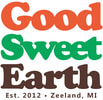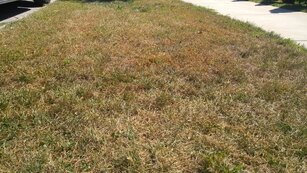 Overseeding your lawn is a really important part of having a thicker, healthier and greener lawn with less weeds. It really isn't difficult to do, but it does require some knowledge to get the most germination for your buck. Read on to learn the why, what, how, when and where of overseeding your lawn. Keep in mind, we're a West Michigan-based company, so our recommendations are targeted for this region. Why should you overseed your lawn? Nature loves diversity. On the flip side, it hates a monoculture. Our efforts, as 21st century American homeowners, to create a monoculture in our lawns goes directly against what nature wants. So, left to its own devices, your lawn is going to have a lot of diversity popping up. You might better know this diversity as "weeds." You don't want weeds (and you don't want to use herbicides)? Put down grass seed and over time, it will push out the weeds. Now you've got three options when facing the idea of lawn diversity: 1) Let it happen. Just unconditionally accept the diversity popping up in your lawn and love it as you would love a pasture growing wild in the countryside. 2) Drop chemical herbicides onto it. This is how golf courses and baseball fields roll. They put down chemical herbicides to both prevent and kill weeds. It's also how most Americans have been conditioned by the chemical lawn industry to approach their lawns. ("Weeds are BAD!") Or (our favorite choice) 3) Employ better lawn management practices. This means fertilizing with an organic fertilizer to get richer soil that turf actually wants to grow in. It means watering deeply a couple times a week to encourage deeper roots. It means setting your mower to its highest setting. And it means overseeding your lawn once, and maybe even twice, every single year. The importance of overseeding comes from the fact that weed seeds can find even the smallest gap in your lawn to germinate and establish roots. If you can put down grass seed before the weed seeds can germinate, you'll have grass growing there instead of something you don't want Now, if you're going to opt for an organic lawn, you're going to have to accept Option 1 to a certain degree. Going organic, you should always expect (and even strive for), at minimum, 10% diversity in your lawn. Anything less than that just isn't healthy. If your lawn is more than 90% grass, you're opening yourself up to pest infestation, fungal infection, higher water bills, etc. But allowing some other stuff (clover, dandelions, violets, etc.) to find a home on your lawn will help keep things balanced and healthy. And telling yourself that some diversity is good for your lawn will even help you relax a bit and enjoy your lawn more, without the stress of striving for perfection weighing you down all summer. I only recommend Option 2 (chemical herbicides) as a very last resort, and as an organic lawn guy, I don't make specific chemical recommendations. But if your yard has become more than 50% weeds, and you're not happy with how it looks, I'd advise researching ways to start over by killing off what's there, and doing a complete re-seed or re-sod. If you've just got areas that are becoming infested with weeds (creeping charlie, for instance), at the very most, spot treat with an herbicide to kill of the stuff in that area, then re-seed. Again, these are last resorts in my opinion. Pulling up weeds and overseeding is a much more sustainable option But keeping weeds out isn't the only reason you should overseed. Does your lawn do better in certain parts of your yard than others? Maybe your shady backyard is thick and lush, while your sunny front yard is looking thin and brown during the hot summer months. Maybe the grass under the shade of a tree looks good, while the grass that doesn't receive shade looks terrible. If so, there's a chance your yard was initially seeded or sodded with the wrong type of grass. If a shade-loving grass was put down in an area that never gets shade, it's always going to struggle. Likewise, if a sun-loving grass gets put in a shady area, it's not going to thrive either. So what's a homeowner to do to fix this sun/shade problem? Overseed with a sun/shade grass seed mix.
0 Comments
 Having a healthy and attractive lawn isn't really a "set it and forget it" operation. There's mowing, watering, fertilizing, and then there are other optional tasks like aerating, weeding and de-thatching. But one relatively easy task many homeowners overlook when it comes to the health of their lawn is overseeding. Lawns can take a beating over the course of a year: pets doing their business, kids playing, high foot traffic, drought, squirrels digging, ice-melt run-off in the winter, and more. Turf can thin out over the course of a year, just from normal wear-and-tear. That wear-and-tear can cause gaps in your lawn, and those gaps can make your yard look worn. Even worse, those gaps are where weeds pop up! Nature hates empty space. If you've got a gap on your lawn-- even a nickel-sized gap-- something's going to pop up there: crabgrass, Canada thistle, dandelions, chickweed, or other annoying plants. Now, I'm not opposed to some diversity in a lawn, but too much can make a lawn look ragged. The best way to combat those weeds naturally is to take away the space where they're most likely to germinate, and the best way to do that is to overseed with a sun/shade grass seed every late-summer or fall (September-October). You can also overseed in the spring (April to early-May), but your grass seed will be competing for space, water and nutrients with weed seeds. Really the only time you shouldn't overseed is summer (late-May-August) and winter (November-March). Good Sweet Earth sells an uncoated sun/shade grass seed perfect for overseeding in Michigan (and other cool-temp grass zones). For areas where you struggle to get grass to thrive, we have an all-natural soil amendment called Lawn Soil, especially blended to help grass seed germinate and grow strong in its first month of life. If you'd like to save a ton of money on grass seed, consider joining our Seed Club. You pay a one-time membership fee, and you're a member for life. Once you join you can save 50% (Gold Membership) or 10% (Green Membership) on all yard seed purchases with Good Sweet Earth for the rest of your life! 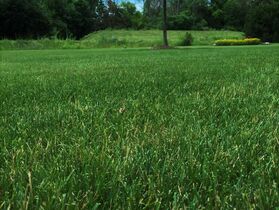 This is a Q&A blog series on healthy organic turf. If you have a question for Good Sweet Earth's lawn guy, Steve, shoot him an email at [email protected], and include "Ask the Lawn Guy" in the subject line. I got this question via email last week: Give me one good reason why I should have an organic lawn. Modern science has given us tools to have a green lawn without weeds, why shouldn't I use them? I can do better than one good reason, I can give you three. First, healthy grass comes from healthy soil. Synthetic chemical fertilizers kill your soil, which in turn kills your turf and makes it overly reliant on chemicals. Dead, sterile soil is also a breeding ground for weeds and disease. Organic fertilization focuses on feeding your soil and developing a healthy ecosystem of bacteria, fungi, worms and other life below the surface of your yard. We use vermicompost (nutrient-rich compost made by earthworms), microbial tea (a liquid rich in microbes to help break down organic matter in your soil), and all-natural slow-release fertilizers. Modern science may have convinced us we can only grow a healthy yard with synthetic chemicals, but nature itself has given us the most effective ways to grow things: water, microbes and organic matter. We've only had synthetic chemicals for our lawns for about 60 years, but things grew just fine for billions of years before that. Second, many people in the United States have made the switch to buying organic produce, yet continue to dump chemicals on their lawn and garden. There's a real disconnect there. If you're concerned with how your food is grown on a farm, you should be even more concerned with how your grass (and garden) are grown in your own yard. If you don't want your family exposed to chemicals on the foods you eat, why would you want to expose them to chemicals in your yard? Third, synthetic chemicals are destroying our ecosystem. These chemicals leach into our watersheds, they kill the life found in our lakes, rivers and streams, they cause algae blooms, and ultimately introduce poisons into our environment. Organic soil management practices can reduce the effects of climate change by helping soil hold on to carbon more effectively. This type of healthy soil management doesn't have to be limited to farms, it needs to start right in each of our yards. In fact, lawns cover more acreage in the United States than any other crop. That means the management practices adopted by homeowners could have a larger impact on our nation's soil and climate than the actions of our farmers. If you live in Kent, Ottawa, Allegan or Muskegon Counties in West Michigan, and you'd like to learn more about organic lawn care for your own home, give us a call at 616-594-0693 or email us at [email protected]. 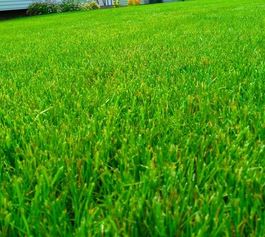 Since autumn is just around the corner, that means your lawn’s growing season is just around the corner as well. You may have noticed your grass slows down during the summer months—it doesn’t grow as fast, which means less mowing, and it often takes on a brownish hue, some might even call it “crispy.” This, of course, is completely normal for Michigan lawns. The hot summer months are the dormant period for cool-weather grasses. But as the daytime temps dip into the 70s more regularly, and precipitation picks up, you can expect your lawn to start “growing and greening” again. With that, there are some things you can do to make your lawn healthier and thicker. 1. Fall is a great time to fertilize. Good Sweet Earth applies organic fertilizer (an alfalfa blend fertilizer) twice a year: in spring and fall. If you were going to only apply fertilizer one time a year, I recommend fall over spring. Why? A few reasons: First, fall fertilization gives your lawn some nutrients before the long, harsh winter. This will make it less distressed when spring rolls around. It also adds organic matter to your soil to help insulate the roots a bit. Second, if you’re applying slow-release organic fertilizer, it won’t break down entirely before winter sets in, which means there will likely be some semi-composted product still on your lawn in the spring; it’s sort of an early spring meal for your lawn which will help green it up early and get it growing strong. Finally, there are less weeds germinating in the fall, which means the nutrients you put in your soil will be more available for your grass, instead of those nasty invasive plants you’d rather not be fertilizing. If you're interested in having us apply some alfalfa blend fertilizer to your lawn, get in touch. 2. Fall is the ideal time to overseed. Like fertilizing, you can overseed in either spring or fall. I prefer late summer/early fall because your grass seeds won’t be competing for space with weed seeds as much. Those gaps in your lawn where grass isn’t growing are prime real estate for weeds. But as your soil gets healthier from organic lawn treatments, those gaps will fill in with grass—unless weeds get there first! In the fall, there are less weed seeds looking for a home, so putting grass seed down in late-August or earl-September (you could do it as late as the first part of October, especially if we have a warm fall) will ensure the grass has a head start over the weeds come spring. To overseed, first, mow your grass lower than you normally would; if the clippings are especially long or clumpy, rake them up so the seed can fall easily to the soil below. Second, buy a sun/shade mix and apply it with a spreader or scatter it evenly by hand. The rate you should be applying is typically 4-6 pounds per 1000 square feet (a 10,000 square foot turf space should be overseeded with about 50 pounds). For bare spots in your lawn: Mix the seed with a little potting soil (soil + compost) and apply it directly as a patch. If rain’s not in the forecast, water it regularly. Every year you do this will mean thicker and less weedy turf. 3. If you’re going to aerate your lawn, do it in fall. Summer is a bad time for aeration simply because you don’t want to distress your lawn any more than you have to during its dormancy. In fall, the grass is growing strong and can recover better from the aeration process. If you’re going to aerate, either hire a company to do core aeration (pulling plugs of soil out of the ground), or rent a core aeration machine and do it yourself. Do NOT succumb to the idea of putting spikes on your shoes and walking around your yard. That simply compacts the soil further. To properly aerate, you need to pull plugs out of the ground so that water and air can get in. Poking holes with spikes won’t do that. That being said, aeration is typically only necessary once every few years, and usually only with over-chemicaled yards. When soil is healthy, full of microbes, worms, bugs and organic matter, it doesn’t need core aeration—the worms and bugs and microbes aerate it for you. 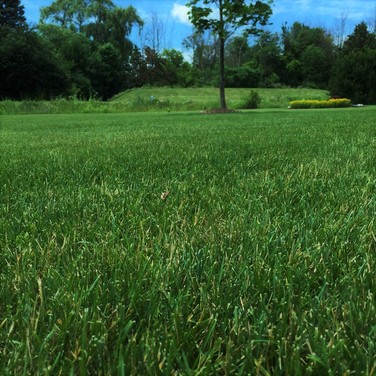 A couple weeks ago, I taught a class at Meijer Gardens in Grand Rapids on eco-friendly lawns. I have to say, preparing to teach a class on your life’s work really helps you organize your thoughts and mission. I came out of this experience with a clearer understanding of, not just how I approach organic lawn care, but why I do it the way I do. I’ve always thought of myself as a “lawn guy.” I’m certified in lawn care management through the University of Georgia, I’ve joined the National Association of Landcare Professionals (NALP), and I help people get their turf strong and healthy. That would fit most people’s definitions of “lawn guy.” But after doing this class at Meijer Gardens, I realized I’m not so much a “lawn guy” as I am a “soil guy.” But the two aren’t mutually exclusive. If you’re a lawn guy without also being a soil guy, you’re potentially doing long-term damage to the turf (not to mention the planet). If a lawn guy is simply interested in getting your lawn green and weed-free in a matter of days, with no concern for the health and fertility of the soil below, your lawn’s going to suffer. Applying synthetic chemical fertilizers and herbicides kill the soil, plain and simple. But as a lawn guy, who’s also primarily a soil guy, I’m more interested in creating healthy soil—full of microbes, worms, beetles, organic material, nutrients that don’t leach away—than I am in making your lawn instantly green and weed-free. Healthy soil will give you healthy turf. Dead soil will give you, well, dead turf. Now don’t get me wrong, I’m still interested in giving people a lawn that’s green and relatively “weed free,” but there’s no magic instantaneous potion that can do that while NOT killing the soil, and don’t let anyone tell you otherwise. And that’s why I am so passionate about feeding the soil, rather than the grass. That’s how nature’s been doing it for millennia. Soil damaged by synthetic chemicals will ultimately give you weak turf and “dead zones” where weeds pop up and grass just doesn’t grow… and then the chemical lawn guys will tell you how much you need them to get your lawn looking good again. And it’s true, in a twisted way—through chemicals, they’ve created a lawn that is wholly dependent upon more environmentally-damaging chemicals for its survival. But what your lawn really needs is healthy soil. Healthy soil will give you healthier, stronger turf. Healthier, stronger turf will push out those pesky plants we know as weeds. And that’s why my focus is to give our customers healthy soil—by feeding your soil with microbes, compost, natural fertilizers like alfalfa and kelp. So when I work on a lawn, I’m doing it as a “soil guy” first and foremost. And when you take care of the soil, your lawn is actually sustainable and healthy, not dependent and weak. If you'd like to have Good Sweet Earth give you a healthier lawn by improving your soil, get in touch with me at [email protected] or call us at 616-594-0693. |
